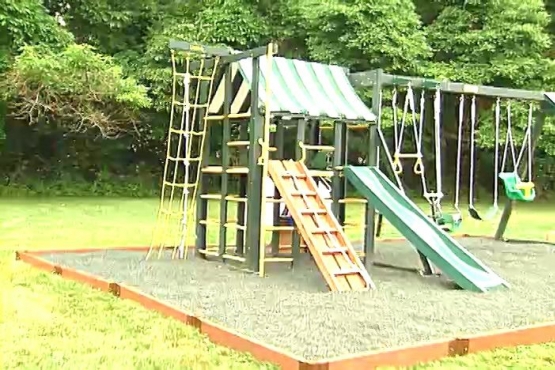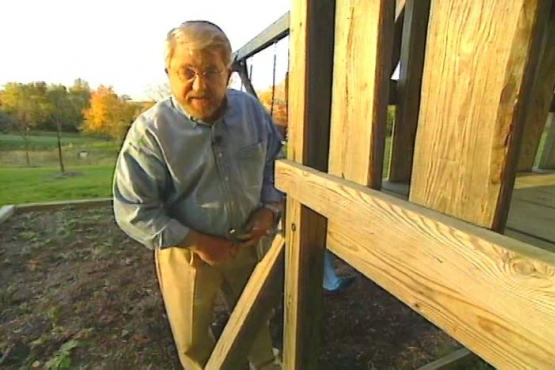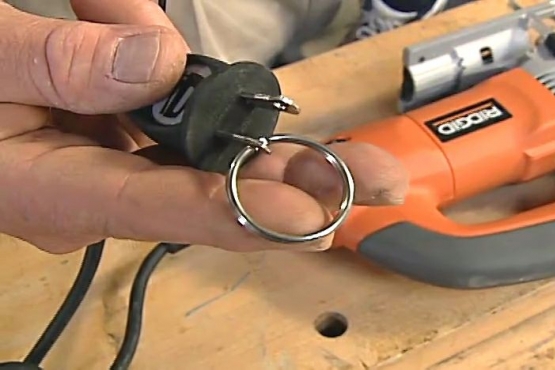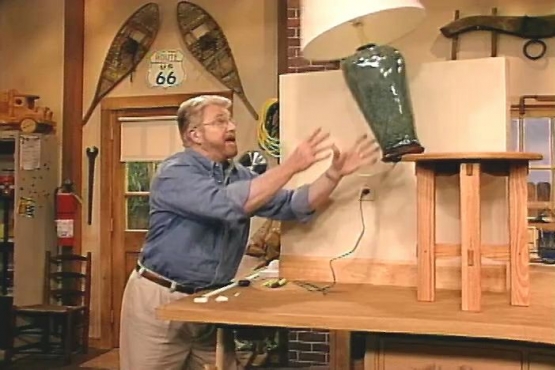RON HAZELTON:
Well, this is my friend Ishaan and he goes to the same school that my two children do and he has to really big interests I understand. One is building things, he helps his dad out a lot with all kinds of projects around the house and he likes television. So, I’ve invited him over here to build something. We’re going to do it together and we’re going to be using a brand new table saw that’s safe for kids and a new material. So, you ready to start?
Ishaan and I have decided to build a box, complete with hinged lid, metal corners and a hasp.
Now, Ishaan, this is the wood that we’re going to be using today but you know what? It’s not really wood.
ISHAAN:
Yeah, it looks cool but.
RON HAZELTON:
It does look cool and it feels kind of like wood but its…
ISHAAN:
Yeah.
RON HAZELTON:
…actually something called polyurethane and you know what this is made from?
ISHAAN:
What?
RON HAZELTON:
Soy beans.
ISHAAN:
Soy Beans?
RON HAZELTON:
Yeah. Pretty cool, huh?
ISHAAN:
Oh…cool.
RON HAZELTON:
And the reason we’re using this instead of wood is because the saw you’re going to be using will cut this pretty easily but it won’t cut wood and that’s one of the reasons that it’s safe.
ISHAAN:
Yeah.
RON HAZELTON:
Alright? I’ve made up some templates, okay? There’s one for the top of the box. There’s one for the bottom of the box, there’s one for the sides, there’s one for the front and there’s one for the back. Okay?
So what you’re going to do is take these templates, you’re going to put them on the material and you’re going to trace the outline first of all. And then we’re going to come over here to the saw and we’re going to cut all these out.
ISHAAN:
Okay.
RON HAZELTON:
Projects designed for older children may require reading measurements and transferring those measurements to the saw. However, since we already have a template, I’m going to use this to set up the saw. I’m going to lay the template right up against the blade like that. Then we’re going to bring the fence in like this.
When set, we want the template to slide snugly between the fence and the blade. Whenever we use a power tool like this, we want to protect our nose, we don’t want to get, breathe in any dust, and we want to protect our eyes.
ISHAAN:
Okay.
RON HAZELTON:
Okay? The blade on this table saw I’ve invented, is oscillating instead of rotating. Consequently, I can touch the running blade without injuring my skin.
[MUSIC]
Even though this saw won’t cut skin, it’s important to teach children to respect the tool as if it were the real thing. Safety and operating procedures learned here are important and will transfer to the use of traditional power tools when the child gets older.
[SAWING SOUNDS]
RON HAZELTON:
All the way. Good. All the way. Good. Congratulations.
[MUSIC & SAWING SOUNDS]
This is the piece you cut out. Let’s put it on top. Perfect.
ISHAAN:
Okay.
[MUSIC & SAWING SOUNDS]
RON HAZELTON:
Excellent. Now, to make these cuts right here,
ISHAAN:
Yep.
RON HAZELTON:
We’re going to use this.
ISHAAN:
What is one of those?
RON HAZELTON:
This is called a miter gauge.
ISHAAN:
Yep.
RON HAZELTON:
You know about this? Seen this before?
ISHAAN:
Yeah, I think I have.
RON HAZELTON:
Really? Wow. Now here’s what we’re going to do with this. We’re going to lay this in here like that, okay? This is called a stop block. And what it’s going to do, is tell us exactly where to position that piece that we’re going to cut off. So drop this in here at the very end of your template and this is a clamp. We’re going to drop this clamp on like this. Any time you want to cut several pieces to the same length, you do this.
[SAWING SOUNDS]
RON HAZELTON:
Okay, so we’ve got the top.
ISHAAN:
Yes.
RON HAZELTON:
Bottom. Back. Front and two sides. Nice line, yeah. Almost any glue can be used with this soy-based polyurethane. Today we’re using a quick-setting cyanal acrylate or superglue as it’s sometime called, readily available in almost any hobby store.
Okay, go ahead and put this side on. This is called a vice-grip or a locking plier. Okay? We’re going to use standard six-penny finish nails as pins to hold the parts together until the glue dries. Just shove it in.
ISHAAN:
Like that?
RON HAZELTON:
Uh hmm. Push it in. As far as you can go. Far as you can go. Keep going. Keep going. Good. Okay. Now, to unlock this you push that lever down. Good. Now, we’re going to take the hammer and hammer it the rest of the way in.
[HAMMERING SOUND]
ISHAAN:
Into here.
RON HAZELTON:
Good. Terrific.
ISHAAN:
Okay.
RON HAZELTON:
Just a little bit. There you go.
The great thing about this non-toxic, vegetable-based polyurethane, is that it’s biodegradable, can be attached with wood glue, apoxy, polyurethane or hot-melt adhesive, as well as screws and nails.
[HAMMERING]
[MUSIC]
Next, we use a nail set to countersink the heads below the surface.
Good.
ISHAAN:
We’re going to have to block this hole too, right?
RON HAZELTON:
Yep. We repeat the nailing and gluing process for the remaining sides of the box.
ISHAAN:
It feels so cool.
RON HAZELTON:
A nice feature of the non-toxic, soy-based polyurethane material is that it allows children to learn good nailing technique quickly and experience real progress, eliminating the frustration that children often feel when trying to drive nails into wood.
[HAMMERING]
Ordinary wall spackle is used to fill the nail holes. Once the spackle is dry, it’s time for a little sanding.
What we’re going to do is take a piece of sandpaper, fold it in thirds like that and like that.
ISHAAN:
So it can get strong, right?
RON HAZELTON:
Stronger. See it’s stiffer, right? Right? Now you can go ahead and sand.
Both the spackle and material sand easily and dust is removed with a paper towel or cloth.
You’re just a natural at this, you know that?
ISHAAN:
Huh.
RON HAZELTON:
Unlike other types of rigid foam, this soy-based polyurethane can be painted with aerosol spray paints. It can also be coated with acrylic latex or oil based paints.
Ah, you did a great job on the painting the box. And that’s the top, okay? Now, we’ve just got to make it so that we can open this up and then close it again, right?
ISHAAN:
So I think we need this.
RON HAZELTON:
Do you know what this is called?
ISHAAN:
Umm..hinges?
RON HAZELTON:
Hinge. Uh huh. And this particular hinge, it’s really long like this, is called a piano hinge. Now we’re going to be using these tiny screws right here. See them?
ISHAAN:
Yeah.
RON HAZELTON:
Now the only problem, is in this material, those screws are so small that they really may not hold well enough so we’re going to add a little apoxy to them.
Today we’re using an apoxy that has a work time or pop-life of about ten minutes.
I’m going to hold this hinge in position right here and I’m going to ask you to put a little hole right in the middle of each one. Perfect. I’m going to hold like this and I’m just going to wipe it in the glue and then push it in the hole. You do the same thing.
ISHAAN:
The end of it?
RON HAZELTON:
Uh hmm.
[MUSIC]
Just plug it up.
[MUSIC]
RON HAZELTON:
Wow, fantastic. What we’re going to, is I’m going to hold this over here.
[MUSIC]
ISHAAN:
There. There. There.
[MUSIC]
RON HAZELTON:
That’s why I can tell you’ve done other projects. You’ve had practice. Working with Dad, right?
ISHAAN:
Yeah.
[MUSIC]
Close and open.
RON HAZELTON:
Now I think we need a couple of..
ISHAAN:
Oooh…corners.
RON HAZELTON:
Right. So we don’t have to worry about …
[MUSIC]
RON HAZELTON:
Maybe for the bottom, what do you think of these?
ISHAAN:
Oh no way. What are these?
RON HAZELTON:
They’re like little feet. They go on like that.
ISHAAN:
Yeah, I got to put these on.
RON HAZELTON:
You like those? Just get it started. Now, no keepsake box would be complete without a way to keep the contents secure. So our last step is to add a hasp. Dishawn will fit it with a lock later on.
ISHAAN:
There.
RON HAZELTON:
You did a terrific job today.
ISHAAN:
Okay.
RON HAZELTON:
Can you think about that? You know, you, you cut out all the pieces for this, you glued this all together, you painted it, you put on all the hardware. You know, I think you did a terrific job.
In addition to paint, there a lots of options for finishing a box like this. It can be covered in paper, fabric, foil, emblazoned with jewels, decorated with charms or whatever a child’s imagination can see.










